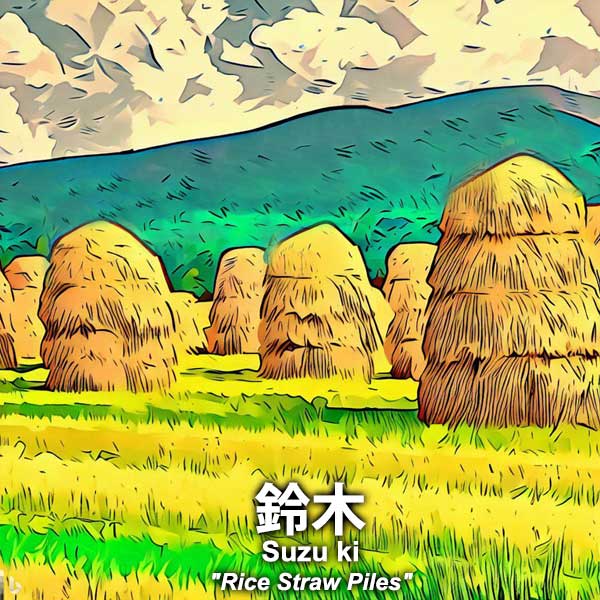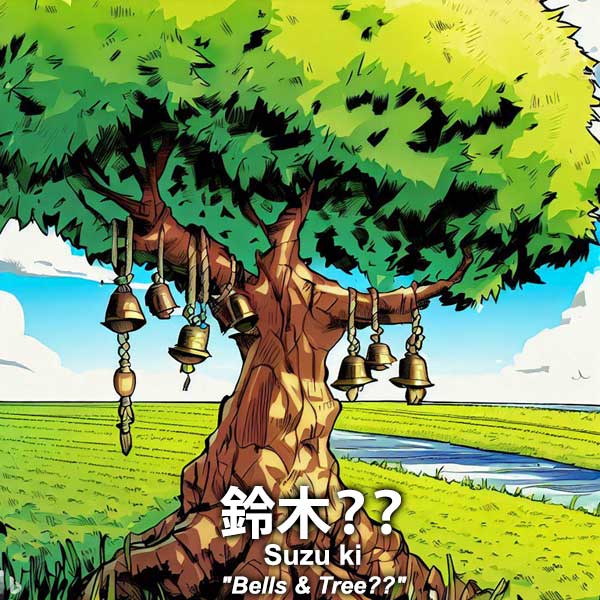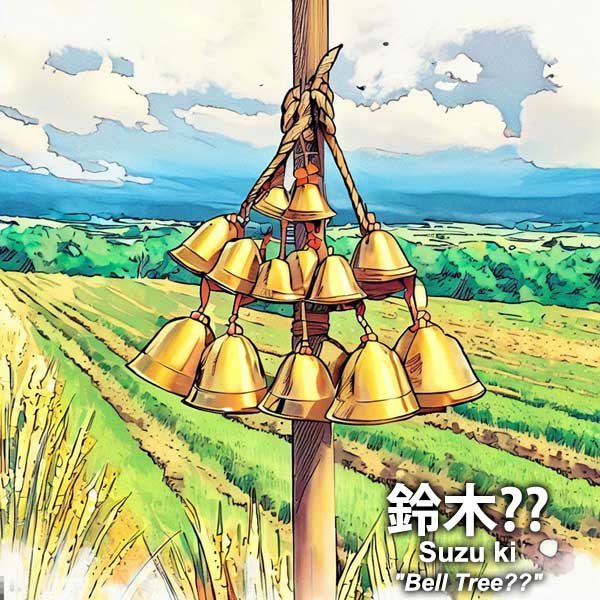
by Philbert Ono, updated Dec. 15, 2024
“Suzuki” (鈴木) is Japan’s No. 2 most common family name, right behind “Sato.” The name’s meaning is very puzzling because the meaning of the kanji characters does not make sense.
It literally means “Bell Tree.” But what the heck is that? A tree with bells?? At first, I could only think of the bell tree used in prayer dances for a good harvest (photo below). This bell tree for real is shaped like a ripe rice plant with ball-shaped bells being the ripe, golden grains of rice. However, it is not called suzuki in Japanese, just suzu.



What does “Suzuki” mean??
If the literal meaning of a family name sounds silly or impossible, it’s probably not the correct meaning. Upon further research, I found out that “Suzuki” actually has a totally different meaning and there’s a long and interesting history (even myth) behind the name.
“Suzuki” turns out to be a rare case where the kanji characters are used only for phonetic purposes (ateji 当て字) and not for the meaning. In other words, the kanji characters for “Suzuki” don’t match the original meaning.
The word “suzuki” (スズキ) in this case comes from Wakayama Prefecture’s Kumano dialect meaning “piles of rice straw” (wara-zuka わら塚) made by farmers as a gesture of prayer to have the rice seeds blessed by the gods for an abundant harvest. The straw would also be used to make shimenawa sacred ropes to hang on the shrine’s torii. (To see actual photos of these rice straw stacks, search for わら塚.)
Since kanji characters were not invented for suzuki in the Kumano dialect, these phonetic kanji characters meaning “bell tree” were used. A few online sources say that “Suzuki” might have originated from susuki which means pampas grass. Probably not.

Who was the first Suzuki?
The original Suzuki family line has mythical beginnings starting with the famous gods of creation named Izanami and Izanagi. A mythical clan named Hozumi (穂積), meaning “piles of rice ears,” then came about and the main ancestor gave an offering of rice plants to legendary Emperor Jimmu, the first emperor who reigned 660 BC – 585 BC. This ancestor thereby received the name of Hozumi.
In the 10th century, the first human descendant named Suzuki Mahito (鈴木真人) became the first Suzuki to appear in name. Since it was in the Kumano region, instead of the word hozumi, the local dialect called it suzuki to refer to piles of rice ears/straw. It was a variant of Hozumi, and Suzuki was adopted as the family name instead.
Originally a family of priests at Fujishiro Shrine in Wakayama.

In 1150, the 25th-generation Suzuki family head Suzuki Shigehide (重秀) moved to Fujishiro Shrine (藤白神社) in present-day Kainan, Wakayama Prefecture.
The shrine is at the entrance to the sacred Kumano Kodo area, home of Koya-san and the Kumano religion. The shrine is dedicated to Nigihayahi (饒速日命), the sun god and Amaterasu, the sun goddess. They are considered to be the titular gods of the Suzuki family.
The original Suzuki family line (designated as Fujishiro-Suzuki) for generations served as the priest at Fujishiro Shrine to pray for abundant harvests every year. Since it means “rice straw piles” (made as a prayer for good harvests), “Suzuki” has deep roots in rice farming.
Fujishiro Shrine has a Suzuki family tree document spanning 122 generations written on a scroll 20 meters long! It provides much solid evidence for the origin and history of the Suzuki family.
In the 12th century, a Suzuki family member named Shigeyoshi (重善) started a samurai clan named “Mikawa-Suzuki” in Mikawa Province in present-day Aichi Prefecture. This Suzuki line later helped to spread the name in eastern Japan.
Around 1615, the Yoshida family (吉田) took over as the priest of Fujishiro Shrine. Till this day, they continue to serve as the shrine priest. Since “Yoshida” (meaning “Good Fortune Rice Paddy” 吉田) also has a close association with rice farming and prayers for a good harvest, the family is well suited to be the shrine priest.
Meanwhile, in 1942, the original Suzuki family line died out when the last family head, Suzuki Shigeyoshi (重吉), passed away without heirs.
However, the Suzuki family name has survived gloriously as the current No. 2 most common family name in Japan with about 1.75 million Suzukis.
How did we get so many Suzukis?
The spread of Suzukis started when the Kumano mountain religion started spreading throughout Japan from around the 12th century. The Suzukis went out and propagated the Kumano religion nationwide for centuries. The religion was widely accepted because it was also patronized by the Imperial Court which gave it prestige.
It was also a period of civil wars and unease among the masses, and Buddhism was supposedly entering an era of decline called Mappo (Latter Day of the Dharma) when it would provide fewer blessings from the 11th century. People believed the Kumano religion would be their savior after death when they would go to the “heavenly paradise.” (Such unease also led to the founding of other Japanese Buddhist sects claiming to save people.)
To be saved, just pray at a Kumano Shrine. And so Kumano Shrines were established nationwide and people enamored with the Kumano religion even named themselves “Suzuki.” Today, there are 2,000 to 3,000 Kumano Shrines in Japan dedicated to the gods of the three Kumano mountains (Kumano Sanzan). Wherever you find a Kumano Shrine, there is usually a Suzuki nearby.
Although the surname originated in Wakayama in western Japan, most Suzuki families are in eastern Japan. It’s not that common in western Japan.
The spread of Suzuki families in eastern Japan is mostly attributed to the Mikawa-Suzuki samurai clan in Aichi Prefecture. In the 17th century, the Suzuki samurai clan were major retainers under Shogun Tokugawa Ieyasu. In fact, the most common family name among Ieyasu’s retainers was Suzuki.
Suzuki samurai retainers received land in eastern Japan and went on to populate their areas with many Suzukis. Today, Suzuki is the most common family name in Tokyo, Saitama, Tochigi, Ibaraki, Aichi, Kanagawa, Shizuoka, and Chiba. In Wakayama, it’s only the 14th most common family name with only 4,800 Suzukis.
Suzuki Summit
Although Suzuki is a very common and seemingly ordinary Japanese surname like “Smith” in the U.S., it turns out to be most extraordinary and unique. If your name is Suzuki, visit Fujishiro Shrine (藤白神社) in Kainan, Wakayama Prefecture and pay homage to your Suzuki family sun gods.
The shrine also recently reconstructed the Suzuki Yashiki (鈴木屋敷) which was the shrine priest’s residence for many generations since the 12th century. The shrine also holds a “National Suzuki Family Summit” (全国鈴木サミット) every some years when Suzuki family members meetup. The last and seventh one was in 2013.
Now you know.
*Images of more Japanese family names here: https://photoguide.jp/log/2023/06/japanese-family-names-illustrated/
*Also see “Sato” Japan’s No. 1 family name: https://photoguide.jp/log/2023/06/sato-japanese-surname-origin/
*AI-generated images prompted by Philbert Ono.
Reference:「日本人のおなまえっ! 1 」by Morioka Hiroshi, NHK, 2017, ISBN13: 978-4797673432